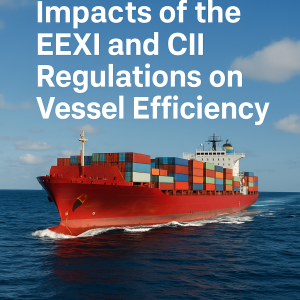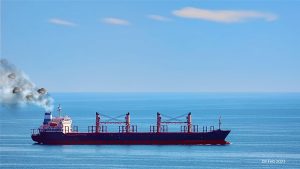Discover how EEXI and CII regulations are reshaping vessel operations. Learn the top 6 impacts on energy efficiency, compliance strategies, and industry innovation in this expert maritime guide.
Why Vessel Efficiency Matters in the Era of Maritime Decarbonization
In January 2023, the International Maritime Organization (IMO) activated two of its most ambitious regulatory tools under MARPOL Annex VI: the Energy Efficiency Existing Ship Index (EEXI) and the Carbon Intensity Indicator (CII). For global shipping, these are not just technical buzzwords—they’re game-changers.
With maritime transport accounting for nearly 3% of global GHG emissions (IMO Fourth GHG Study, 2020), achieving vessel efficiency is no longer optional—it’s essential. The EEXI and CII frameworks aim to force measurable reductions in carbon emissions, but they also introduce a host of operational and commercial implications for shipowners, operators, and crews.
In this article, we break down the top 6 impacts of these regulations, offer case studies from real shipping companies, and explore future pathways for compliance and innovation.

Understanding EEXI and CII: The Basics
The EEXI assesses the energy efficiency of existing ships, applying a similar formula used for the EEDI (Energy Efficiency Design Index) for new vessels. It is a technical measure that calculates CO2 emissions based on engine power, fuel consumption, and ship design.
Meanwhile, the CII is an operational indicator that measures a ship’s annual CO2 emissions per transport work (grams of CO2 per dwt-mile). It ranks ships from A to E, with C being the acceptable baseline. Ships rated D or E for three consecutive years face penalties.
Together, they form a dual-edged framework targeting both ship design and voyage behavior.
Impact 1 – Accelerated Adoption of Energy-Efficient Technologies
One of the most visible impacts of EEXI/CII is the spike in retrofitting and adoption of energy-saving technologies (ESTs). According to DNV, over 30% of vessels reviewed for EEXI compliance in 2023 required some form of technical modification.
Common Technologies Deployed
- Shaft power limitation (ShaPoLi)
- Engine power limitation (EPL)
- Air lubrication systems
- Rotor sails and wind-assist systems
- Energy-saving propeller upgrades
For example, Maersk implemented engine derating and ShaPoLi on several container ships to meet EEXI thresholds without requiring a full retrofit.
Impact 2 – Operational Slow Steaming Becomes the Norm
CII directly incentivizes slow steaming, a tactic where vessels operate at lower speeds to reduce fuel consumption. A 10% speed reduction can cut fuel use by up to 27%, significantly improving CII ratings (Lloyd’s Register, 2023).
However, this has downstream effects:
- Longer voyage durations
- Port scheduling challenges
- Increased charterer pressure
Many shipping firms now integrate weather routing and dynamic speed optimization to balance CII scores with timely delivery.
Impact 3 – Vessel Marketability Tied to Ratings
CII ratings have become a competitive differentiator. Charterers, financiers, and insurers are increasingly evaluating ships based on their CII performance.
For instance, Shell and Trafigura have publicly stated they prefer chartering vessels with CII A or B ratings. A poor rating (D or E) could lead to reduced charter rates, or even contract refusal.
Some ports—like Singapore and Rotterdam—are considering incentives (lower port dues) for high CII-rated vessels.
Impact 4 – Increased Compliance Burden and Data Reporting
To remain compliant, ships must submit a detailed Ship Energy Efficiency Management Plan (SEEMP) Part III, including:
- CII rating targets
- Implementation plan
- Self-evaluation methodology
Compliance requires accurate fuel consumption and voyage data. Digital platforms and automated emissions monitoring systems are now essential tools. Companies like Wärtsilä and Alfa Laval offer EEXI/CII compliance packages integrated with performance dashboards.
Impact 5 – Scrapping and Fleet Renewal Decisions
Older vessels with poor design efficiency face a stark choice:
- Invest in costly retrofits
- Accept degraded market value
- Exit the market entirely
According to Clarksons Research, scrapping rates increased by 15% in 2023, with older bulk carriers and tankers being phased out. Simultaneously, newbuild orders now prioritize energy-efficient hull forms and dual-fuel (LNG, methanol, ammonia) capabilities.
Impact 6 – Shift in Operational Culture and Crew Training
EEXI and CII have catalyzed a shift from traditional operational thinking toward data-driven voyage management. Crews must now understand:
- Fuel optimization strategies
- CII rating dynamics
- Digital emissions reporting tools
The IMO Model Course 4.05 and other training modules now include CII monitoring principles, fostering a new generation of sustainability-aware seafarers.

Case Studies / Real-World Applications
Case Study 1 – NYK Line (Japan)
NYK adopted voyage planning software integrated with real-time weather routing, reducing carbon intensity by 13% in 12 months across its dry bulk fleet.
Case Study 2 – MSC Mediterranean Shipping Company
MSC deployed rotor sails and ShaPoLi on several container vessels, achieving a 20% improvement in energy efficiency on selected routes.
Case Study 3 – Hafnia Tankers
Hafnia introduced crew training programs based on CII dynamic modeling, resulting in better decision-making and a fleet-wide average CII rating of B by Q4 2023.
Challenges and Solutions
Challenges
- Inconsistent data quality from ship to shore
- High cost of retrofitting
- Complexity in voyage planning under slow steaming
Solutions
- Use of cloud-based emissions monitoring (e.g., Inmarsat’s Fleet Data)
- Port-state collaboration to align arrival windows with slow steaming
- Financial incentives and carbon credits to offset compliance costs
Future Outlook: From Compliance to Competitive Advantage
EEXI and CII are not static regulations. The IMO is expected to tighten CII thresholds in 2026, and there’s growing talk of integrating life-cycle emissions into ship ratings.
Forward-looking shipowners are investing in:
- Dual-fuel engines (methanol, ammonia-ready)
- Alternative propulsion systems
- AI-driven voyage optimization platforms
Ultimately, those who treat compliance as an opportunity for innovation will lead in an increasingly carbon-conscious marketplace.
FAQ
Q1: What is the difference between EEXI and CII?
A1: EEXI is a technical measure evaluating ship design efficiency, while CII assesses actual operational carbon intensity on an annual basis.
Q2: What types of vessels are affected by EEXI and CII?
A2: Most cargo and passenger ships over 5,000 GT are subject to both regulations under MARPOL Annex VI.
Q3: Can a vessel improve its CII rating without retrofitting?
A3: Yes. Adjusting voyage speeds, improving weather routing, and optimizing cargo loading can enhance ratings.
Q4: What happens if a vessel receives a poor CII rating?
A4: It must submit a corrective plan. Persistent D or E ratings may trigger flag-state action or reduced marketability.
Q5: Are ports involved in enforcing CII/EEXI?
A5: Not directly, but some ports incentivize high-performing ships through discounts or priority berthing.
Q6: Is there financial help for compliance?
A6: Yes. Some classification societies and banks now offer “green financing” for compliant upgrades or newbuilds.
Q7: What role does crew play in meeting CII targets?
A7: A major one. Crews manage engine settings, voyage speed, and reporting tools, directly influencing carbon output.
Conclusion
The introduction of EEXI and CII under MARPOL Annex VI is a landmark shift toward a more transparent, data-driven, and environmentally responsible shipping industry. These regulations are not merely checkboxes for compliance—they are the new compass points guiding maritime sustainability.
As the industry faces rising climate expectations and regulatory scrutiny, aligning operations with EEXI and CII standards offers not only a pathway to compliance but a strategic edge in a greener global economy.
References
- IMO EEXI and CII Guidelines
- DNV EEXI/CII Insight Reports
- Lloyd’s Register – EEXI and CII Tools
- Clarksons Research Intelligence
- IMO Fourth GHG Study
- Wärtsilä Marine Emissions Solutions
- Alfa Laval Marine Efficiency Technologies
- Inmarsat Fleet Data
- Maersk Decarbonization Strategy
- MSC Sustainability Report 2023
- NYK Line Environmental Strategy
- Hafnia ESG Reports

